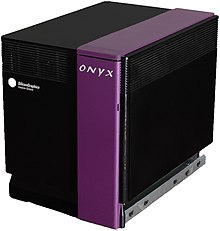
Silicon Graphics, Inc. was an American high-performance computing manufacturer, producing computer hardware and software. Founded in Mountain View, California in November 1981 by James Clark, its initial market was 3D graphics computer workstations, but its products, strategies and market positions developed significantly over time.

The SGI Indigo2 and the SGI Challenge M are Unix workstations which were designed and sold by SGI from 1992 to 1997.

The Octane series of IRIX workstations was developed and sold by SGI in the 1990s and 2000s. Octane and Octane2 are two-way multiprocessing-capable workstations, originally based on the MIPS Technologies R10000 microprocessor. Newer Octanes are based on the R12000 and R14000. The Octane2 has four improvements: a revised power supply, system board, and Xbow ASIC. The Octane2 has VPro graphics and supports all the VPro cards. Later revisions of the Octane include some of the improvements introduced in the Octane2. The codenames for the Octane and Octane2 are "Racer" and "Speedracer" respectively.
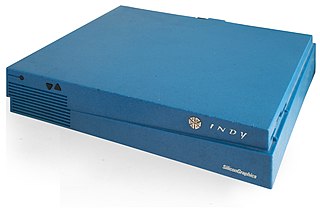
The Indy, code-named "Guinness", is a low-end multimedia workstation introduced on July 12, 1993 by Silicon Graphics Incorporated (SGI). SGI developed, manufactured, and marketed Indy as the lowest end of its product line, for computer-aided design (CAD), desktop publishing, and multimedia markets. It competed with Intel x86 computers, and with Windows and Macintosh, including using their files and running their applications via software emulation. It is the first computer to come standard with a video camera, called IndyCam.

The SGI Tezro is a series of high-end computer workstations sold by SGI from 2003 until 2006. Using MIPS CPUs and running IRIX, it is the immediate successor to the SGI Octane line. The systems were produced in both rack-mount and tower versions, and the series was released in June 2003 with a list price of US$20,500. The Tezro was released alongside the SGI Onyx4 and rack-mountable Tezros share many components with it, including plastic skins. The rack-mounted Tezros are functionally very similar to an Infinite Performance-equipped SGI Onyx350. Tezro marked the return of the original cube logo to SGI machines.

The O2 is an entry-level Unix workstation introduced in 1996 by Silicon Graphics, Inc. (SGI) to replace their earlier Indy series. Like the Indy, the O2 uses a single MIPS microprocessor and was intended to be used mainly for multimedia. Its larger counterpart is the SGI Octane. The O2 was SGI's last attempt at a low-end workstation.

Altix is a line of server computers and supercomputers produced by Silicon Graphics, based on Intel processors. It succeeded the MIPS/IRIX-based Origin 3000 servers.

The IRIS Crimson is a Silicon Graphics (SGI) computer released in 1992. It is the world's first 64-bit workstation.

The SPARCstation, SPARCserver and SPARCcenter product lines are a series of SPARC-based computer workstations and servers in desktop, desk side (pedestal) and rack-based form factor configurations, that were developed and sold by Sun Microsystems.

The Sun-2 series of UNIX workstations and servers was launched by Sun Microsystems in November 1983. As the name suggests, the Sun-2 represented the second generation of Sun systems, superseding the original Sun-1 series. The Sun-2 series used a 10 MHz Motorola 68010 microprocessor with a proprietary Sun-2 Memory Management Unit (MMU), which enabled it to be the first Sun architecture to run a full virtual memory UNIX implementation, SunOS 1.0, based on 4.1BSD. Early Sun-2 models were based on the Intel Multibus architecture, with later models using VMEbus, which continued to be used in the successor Sun-3 and Sun-4 families.
VPro, also known as Odyssey, is a computer graphics architecture for Silicon Graphics workstations. First released on the Octane2, it was subsequently used on the Fuel and Tezro workstations and the Onyx visualization systems, where it was branded InfinitePerformance.
The Challenge, code-named Eveready and Terminator, is a family of server computers and supercomputers developed and manufactured by Silicon Graphics in the early to mid-1990s that succeeded the earlier Power Series systems. The Challenge was later succeeded by the NUMAlink-based Origin 200 and Origin 2000 in 1996.
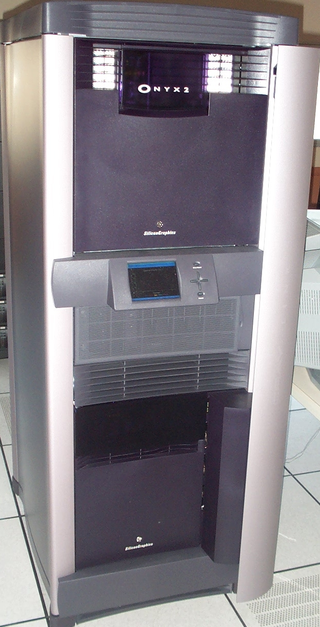
The Onyx2, code name Kego, is a family of visualization systems developed and manufactured by SGI, introduced in 1996 to succeed the Onyx. The Onyx2's basic system architecture is based on the Origin 2000 servers, but with the inclusion of graphics hardware. In 2000, the Onyx2 was succeeded by the Onyx 3000, and it was discontinued on June 27, 2003. These systems run either IRIX 6.4 or 6.5.

The SGI Origin 2000 is a family of mid-range and high-end server computers developed and manufactured by Silicon Graphics (SGI). They were introduced in 1996 to succeed the SGI Challenge and POWER Challenge. At the time of introduction, these ran the IRIX operating system, originally version 6.4 and later, 6.5. A variant of the Origin 2000 with graphics capability is known as the Onyx2. An entry-level variant based on the same architecture but with a different hardware implementation is known as the Origin 200. The Origin 2000 was succeeded by the Origin 3000 in July 2000, and was discontinued on June 30, 2002.
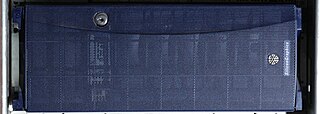
The SGI Origin 200, code named Speedo, was an entry-level server computer developed and manufactured by SGI, introduced in October 1996 to accompany their mid-range and high-end Origin 2000. It is based on the same architecture as the Origin 2000 but has an unrelated hardware implementation. At the time of introduction, these systems ran the IRIX 6.4, and later, the IRIX 6.5 operating systems. The Origin 200 was discontinued on 30 June 2002.
The Origin 3000 and the Onyx 3000 is a family of mid-range and high-end computers developed and manufactured by SGI. The Origin 3000 is a server, and the Onyx 3000 is a visualization system. Both systems were introduced in July 2000 to succeed the Origin 2000 and the Onyx2 respectively. These systems ran the IRIX 6.5 Advanced Server Environment operating system. Entry-level variants of these systems based on the same architecture but with a different hardware implementation are known as the Origin 300 and Onyx 300. The Origin 3000 was succeeded by the Altix 3000 in 2004 and the last model was discontinued on 29 December 2006, while the Onyx 3000 was succeeded by the Onyx4 and the Itanium-based Prism in 2004 and the last model was discontinued on 25 March 2005.
The SGI IRIS series of terminals and workstations from Silicon Graphics was produced in the 1980s and 1990s. IRIS is an acronym for Integrated Raster Imaging System.

InfiniteReality refers to a 3D graphics hardware architecture and a family of graphics systems that implemented the aforementioned hardware architecture that was developed and manufactured by Silicon Graphics from 1996 to 2005. The InfiniteReality was positioned as Silicon Graphics' high-end visualization hardware for their MIPS/IRIX platform and was used exclusively in their Onyx family of visualization systems, which are sometimes referred to as "graphics supercomputers" or "visualization supercomputers". The InfiniteReality was marketed to and used by large organizations such as companies and universities that are involved in computer simulation, digital content creation, engineering and research.
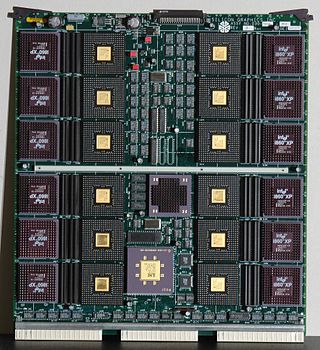
RealityEngine is a 3D graphics hardware architecture and a family of graphics systems which was developed and manufactured by Silicon Graphics during the early to mid 1990s. RealityEngine was positioned as the company's high-end visualization hardware for its MIPS/IRIX platform. RealityEngine is designed for deployment exclusively within the company's Crimson and Onyx family of visualization systems, which are sometimes referred to as "graphics supercomputers" or "visualization supercomputers". The RealityEngine was marketed to large organizations, such as companies and universities that are involved in computer simulation, digital content creation, engineering and research.
